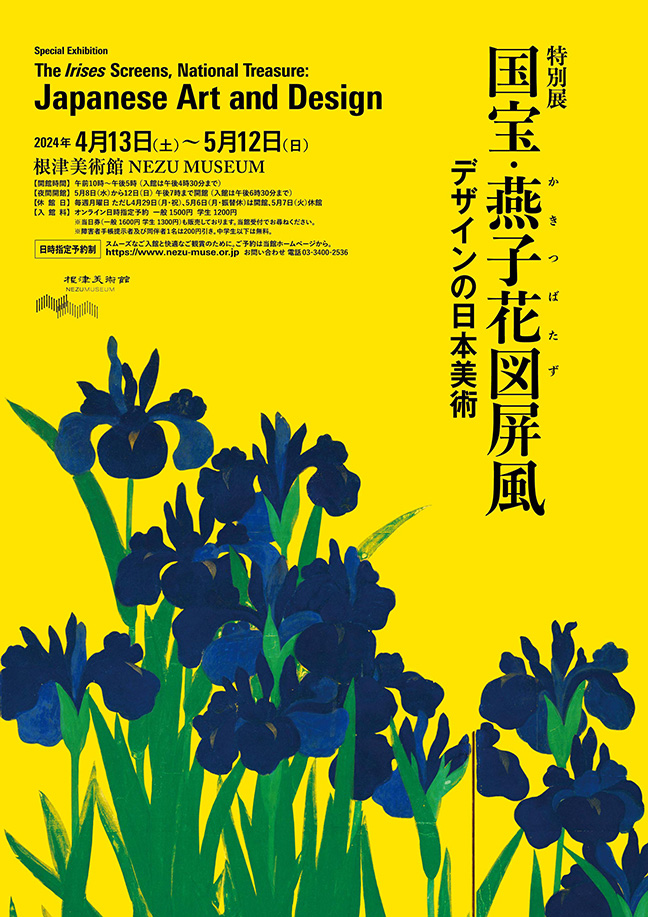
-
Special Exhibit
The Irises Screens, National Treasure
Japanese Art and Design - Saturday, April 13 – Sunday, May 12, 2024


| Closed | Mondays except April 29, May 6 and Closed May 7 |
|---|---|
| Hours |
10 a.m. - 5 p.m.(last entry: 4:30 p.m.) 10 a.m. - 7 p.m. May 8-12 (last entry: 6:30 p.m.) |
| General admission (On-line timed-entry tickets) | Adult 1500 yen, Student 1200 yen |
| Gallery | 1/2 |
The Irises screens by Ogata Kōrin (1658-1716) are a national treasure that straddles the boundary between painting and design. While the painter’s masterful technique is obvious in the flowers thickly painted in azurite blue and the vigorous brushwork in malachite green that created the leaves, there can be no doubt that the core of this work is its geometric layout on a planar surface.
The Irises embody the design sense, or decorative nature, inherent to Japanese art. The intimate ties between painting and the design of craft works in Japan is also noteworthy. Moreover, the Irises can be considered a floral painting that connects with poetry and prose, and a symbolic representation of the literary world through their design.
This exhibition, with the Irises as its centerpiece, focuses on Japanese art from the perspective of design, principally through early modern works.


-
Irises
By Ogata Kōrin - Pair of folding screens; ink and color on gold-foiled paper
- Japan Edo period, 18th century
Nezu Museum - Clumps of rabbit-ear irises bloom gloriously on a gold ground in this work inspired by the scene of the yatsuhashi (eight bridges) and irises in Episode 9, “To the East,” of The Tales of Ise. Kōrin’s lavish use of high quality pigments in this screen painting suggests that the Irises screens were commissioned by a wealthy customer. The result is a work that anticipates graphic design as we know it today.

-
Ogata-gire (Detached Segment of the Narihirashū Poetry Anthology)
Attributed to Fujiwara no Kintō - Hanging scroll; ink on decorated paper
-
Japan Heian period, 12th century
Nezu Museum - This detached segment is from the Narihirashū Poetry Anthology, which was separated in the Edo period (1615-1868) from the Nishi Honganji Temple’s Sanjūrokunin Kashū (Anthologies of Thirty-six Poets), created in the Heian period (794-1185). The poem paper was printed with a splendid motif in mica on gofun (a white pigment made by pulverizing seashells) and a delicate drawing added in silver pigment. This segment was handed down in the Ogata family, of which Kōrin was a member.

- Fan-Shaped Paintings with Waka Poems
- Handscroll; ink and color on paper
-
Japan Edo period, 17th century
Nezu Museum - This painting is from the Ōgi no Sōshi, a collection of fan-shaped works with waka poems and paintings depicting their contents, in the tradition of uta-e, poem-pictures depicting the sentiments and spirits of poems and letting the viewers guess the poems themselves. This example has much in common with the Irises screens, in both its mode of production and poetic appreciation.

-
Cherry Blossoms and Poppies
Inen seal - Four sliding panels; ink and color on gold-foiled paper
-
Japan Edo period, 17th century
Ryushi Kinenkan (Commemorative Hall) - Cherry trees in full bloom spread their branches in all directions in the upper half of the picture plane. Along their lower edge, poppies and other flowers gather, like bouquets. Among the large-format floral paintings created in the atelier of Tawaraya Sōtatsu, this work stands out for its extraordinary design sense.

